America’s Syphilis Epidemic Exposed: STD Rates Soar to Highest Levels Since the 1950s… and One State Has Become the VERY Unlikely Epicenter of the Outbreak
A major outbreak of syphilis is gripping the US, with the number of cases reaching the highest level since the 1950s, official data shows.
An annual report from the Centers for Disease Control and Prevention (CDC) shows that 207,300 cases of the STD – which can cause sores on the genitals and mouth – were diagnosed nationwide in 2022, the latest year available.
That represented an increase of 17 percent in one year and an increase of 83 percent compared to five years ago.
The data also showed a 30 percent increase in cases of congenital syphilis – when the mother passes the disease to her baby – which is of particular concern because it poses a risk of stillbirth and birth defects.
The above graph shows the rate per 100,000 people for the total number of syphilis cases recorded in the US since the 1940s. It shows that they are starting to tick again
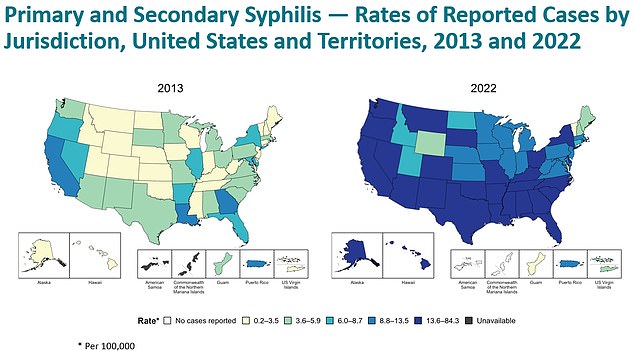
The two maps show how the number of syphilis cases in the US has shifted since 2013
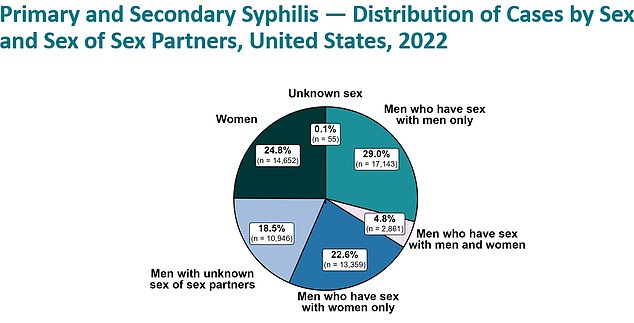
The above shows that syphilis is not only limited to the LGBT population, but is also becoming increasingly common among other groups
Data shows that 2.5 million Americans will contract an STD in 2022 – the same level as last year. But while other diseases such as chlamydia have remained stable, cases of syphilis have increased.
Dr. Laura Bachmann, acting director of the CDC Division of STD Prevention, said, “Within the STD epidemic, syphilis is an isolated infection.
“It has emerged as a unique public health challenge.”
U.S. Secretary of Health and Human Services Xavier Becerra labeled the figures “unacceptable.”
He said, “The Biden-Harris Administration is committed to tackling this urgent problem and using all available resources to eliminate disparities in our health care system.”
The department said it will create a new task force to focus on reducing the number of syphilis cases in the US.
The number of syphilis cases declined in the 1950s due to successful public health campaigns and the widespread use of condoms and penicillin.
By the late 1990s, the CDC had launched the National Plan to Eliminate Syphilis from the United States – saying the goal was within their reach.
But over the past decade, interest rates have started to rise again. Experts have pointed to a range of reasons for the increase, including a decline in condom use, fewer local sexual health clinics and rampant drug use.
Syphilis is a bacterial infection spread through contact with sores that usually appear around the pubic area or mouth.
Symptoms appear within three to four weeks of an infection and often go unnoticed or dismissed as minor abrasions or heat rash.
The disease may then enter a second phase, where the ulcer disappears and is replaced by a rash that can last for weeks.
Without treatment, patients risk the disease spreading to the brain and spinal cord, which can cause complications including headaches, stroke and meningitis – or inflammation of the brain’s protective walls.
There is particular concern about the disease in pregnant women because the bacteria can infect the placenta and developing child, causing complications including vision and hearing loss and low birth weight.
Treatment of the disease involves administering antibiotic injections to patients.
Data from the CDC showed that 3,755 babies were born with congenital syphilis in the US in 2022 – a tenfold increase from a decade ago and a spike of 31 percent in one year. Of these, 282 resulted in stillbirth or infant death.
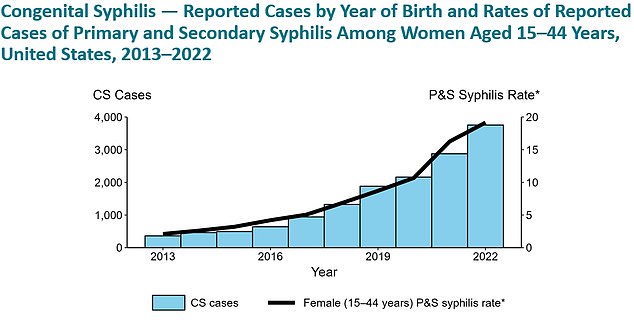
The above shows the number of cases of congenital syphilis recorded in the US, or syphilis infections in pregnant people. These are at risk of birth complications
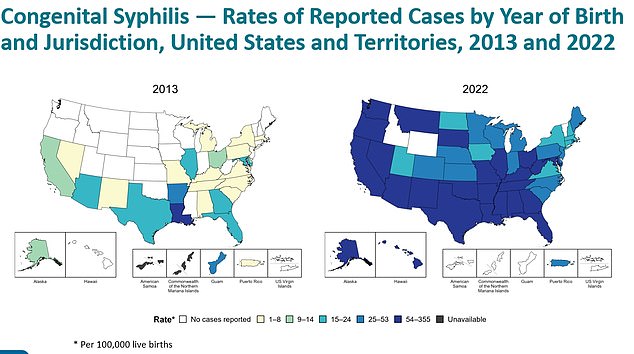
And the map above shows the numbers of reported cases of congenital syphilis by state between 2013 and 2022
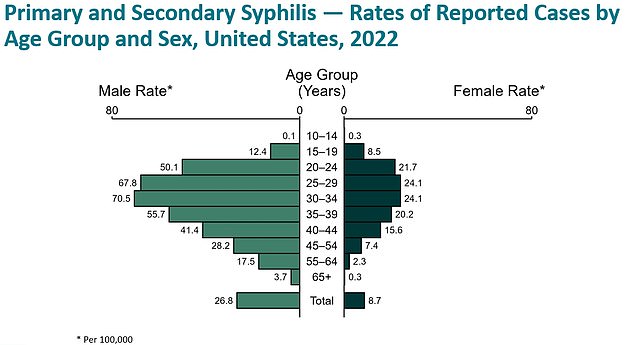
The above shows cases of syphilis by age group, with rates highest among men in their early thirties
South Dakota currently has the highest rate of overall syphilis infections: 84 cases per 100,000 people.
That’s more than double the rates in the next highest state, New Mexico.
Experts say the outbreak in South Dakota is linked to infections transmitted within the Native American community.
Data also showed that 29 percent of those diagnosed with syphilis only had sex with other men.
Another 22.6 percent of cases were diagnosed among men who had sex with women – and 24.8 percent of cases were diagnosed among women.

Within weeks of infection, syphilis can cause sores in the mouth or around the genital area. These are contagious and can transmit the disease
She added: ‘We cannot continue to use decades-old prevention strategies to tackle the current STD epidemic.
“People need testing and treatment to meet them where they are.”
Dr. Philip Chan, a medical officer at Brown University, told NBC News: ‘I think it’s being spread unknowingly among the heterosexual cisgender population because we really don’t test for it.
“We’re really not looking for it.”
